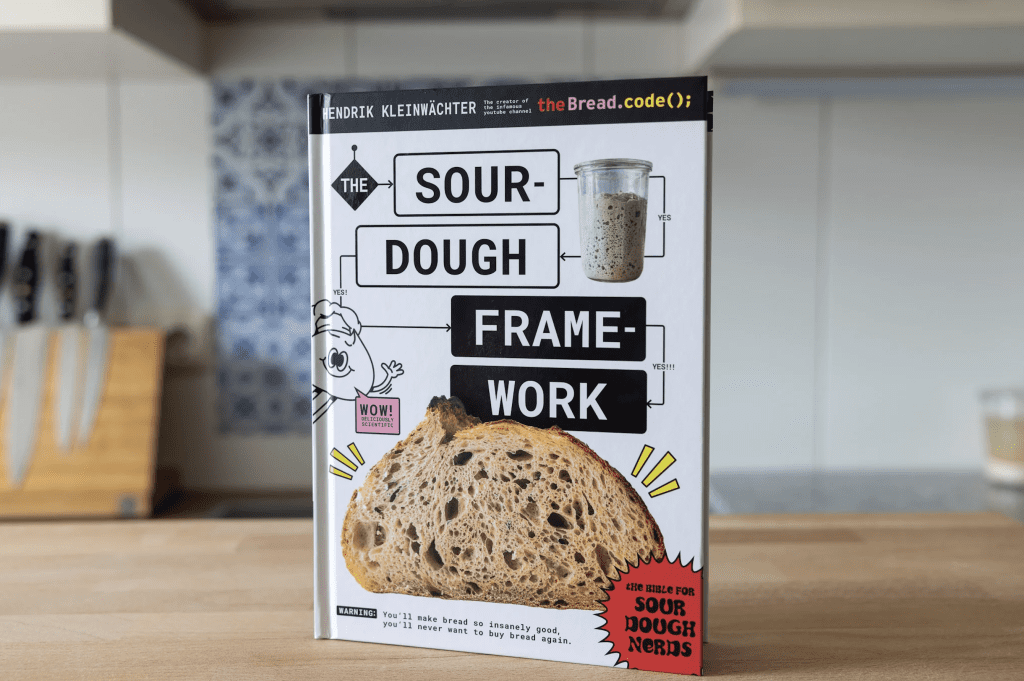For anyone passionate about sourdough breadmaking, The Sourdough Framework by Hendrik Kleinwächter is an unparalleled resource that combines science, history, technical know-how, and the artistry of baking. This groundbreaking book isn’t just a collection of recipes; it’s an educational journey that teaches the science and craft of sourdough from the ground up. Every chapter, glossary term, flowchart, table, figure, and bibliography entry contributes to a rich tapestry of knowledge, making this book the ultimate guide for bakers of all levels.
This blog post article on The Sourdough People explores the book in exhaustive detail, showcasing why it stands out as a must-have for sourdough enthusiasts and how its logical, accessible, and scientific approach elevates it far above standard baking books. Whether you’re a novice eager to bake your first loaf or an experienced artisan looking to refine your craft, this comprehensive book review will illustrate why The Sourdough Framework is essential reading.
Who is Hendrik Kleinwächter? The Engineer-Turned-Sourdough Expert Who Wrote The Sourdough Framework
Hendrik Kleinwächter is a software engineer who turned his analytical mindset to the complex art of sourdough baking. Dissatisfied with the inconsistent results and lack of clarity in many recipes, Hendrik brought his problem-solving skills, precision, and passion for knowledge to breadmaking. His unique perspective and innovative approach have helped redefine what a bread book can be.
Hendrik’s relationship with bread began during his childhood, baking loaves with his mother. This formative experience planted the seeds of a lifelong fascination with bread. Later in life, as he became disillusioned with the quality of industrial bread, he delved deeper into the world of sourdough, finding joy in its authenticity, flavor, and tradition. He transformed his passion into The Bread Code, a YouTube channel dedicated to sourdough baking tutorials and experiments. The success of the channel inspired him to create a more enduring resource—one that would transcend algorithms and deliver timeless knowledge to a global audience.
Why The Sourdough Framework is an Exceptional and Comprehensive Guide to Sourdough Baking
A Scientific Approach to Breadmaking
Unlike conventional baking books, The Sourdough Framework goes beyond surface-level instructions and provides an in-depth exploration of the scientific principles behind every stage of sourdough baking. Hendrik breaks down the microbiology of fermentation, enzymatic reactions, and the interplay of ingredients, helping bakers understand why certain steps are necessary and how to refine their techniques. This approach empowers readers to make informed decisions and adapt recipes with confidence.
Exhaustive Content and Logical Structure
Every aspect of sourdough baking is covered, from the history of breadmaking to troubleshooting advanced techniques. The book’s logical progression makes it accessible to beginners while offering the depth and nuance experienced bakers crave. Each chapter builds upon the last, creating a cohesive and comprehensive learning experience.
Open-Source and Collaborative Philosophy
Hosted on GitHub under a Creative Commons license, The Sourdough Framework is freely available to anyone with an internet connection. This open-source approach reflects Hendrik’s commitment to democratizing access to knowledge. By inviting contributions and feedback from the baking community, the book evolves with new ideas, techniques, and solutions, ensuring it remains a relevant and living resource.
Bridging Tradition and Innovation
The book seamlessly connects ancient breadmaking techniques with modern challenges, such as gluten sensitivity and the industrialization of bread. Hendrik celebrates the authenticity and craftsmanship of sourdough while addressing contemporary issues, making the book both timeless and timely.
A Chapter-by-Chapter Breakdown of The Sourdough Framework: What You’ll Learn and Why It’s Valuable
Chapter 1: The History of Sourdough
Hendrik opens the book with an expansive journey into the origins of sourdough, tracing its story back billions of years to the dawn of microbial life. This chapter isn’t just about the history of bread but the very foundation of fermentation itself. Readers are introduced to the ancient beginnings of yeast and bacteria, the microbial workhorses that have existed for billions of years and are essential to sourdough baking today.
Key highlights include:
- The Evolution of Microbial Life: How ancient microbes laid the foundation for fermentation and the symbiotic relationships that drive sourdough.
- The Discovery of Fermentation: Early humans stumbled upon the process of natural leavening, using wild yeast and bacteria to transform flour and water into bread.
- Cultural Significance: Sourdough’s role in ancient civilizations, from its use in Egyptian baking to its prominence during the Roman Empire.
- Modern Resurgence: The rediscovery of sourdough during the COVID-19 pandemic as home bakers sought solace in traditional breadmaking methods.
This chapter contextualizes sourdough as part of a much larger narrative, connecting the science of microbes to the human journey of innovation and tradition.
Chapter 2: How Sourdough Works
This chapter is a deep dive into the science of fermentation, explaining the biological and chemical processes that make sourdough unique. Hendrik covers:
- Enzymatic Reactions: Detailed explanations of how amylase and protease enzymes break down starches and proteins, creating the sugars and amino acids essential for fermentation and flavor.
- Microbial Interactions: Insights into the symbiotic relationship between yeast and lactic acid bacteria, which work together to create sourdough’s characteristic tangy flavor, airy texture, and extended shelf life.
- Optimization Tips: Practical advice on how to manipulate factors like temperature, hydration, and flour type to achieve desired results.
Chapter 3: Making a Sourdough Starter
The sourdough starter is the foundation of any great loaf, and Hendrik provides an exhaustive guide to creating and maintaining one. Topics include:
- Starter Types: An in-depth look at regular, liquid, stiff, and pasta madre starters, with advice on choosing the right one for your baking goals.
- Feeding and Maintenance: Step-by-step instructions for keeping your starter active and healthy, including feeding schedules, hydration ratios, and storage tips.
- Troubleshooting: Solutions to common problems like weak rise, off-putting odors, mold, and excessive acidity, ensuring readers can rescue struggling starters.
Chapter 4: Sourdough Starter Types
This chapter expands on the basics of starters, exploring their unique characteristics and applications in greater detail. Hendrik provides insights into how different types of starters affect fermentation speed, flavor, and dough texture.
Chapter 5: Flour Types
Flour is a critical ingredient in sourdough baking, and this chapter explains how different types of flour influence the baking process. Hendrik discusses protein content, gluten formation, and how to choose the right flour for specific recipes and textures.
Chapter 6: Bread Types
In this chapter, Hendrik categorizes bread into flatbreads, pan loaves, and freestanding loaves, offering frameworks and recipes for each. He emphasizes experimentation and adaptation, encouraging bakers to create their own variations.
Chapter 7: Wheat Sourdough
This comprehensive guide to wheat-based sourdough covers every step of the process, from ingredient selection to bulk fermentation, shaping, scoring, and baking. Hendrik’s meticulous explanations ensure consistent results for bakers of all skill levels.
Chapter 8: Non-Wheat Sourdough
For bakers interested in alternative grains, this chapter explores non-wheat options like rye and spelt. Hendrik provides tailored tips and techniques to achieve excellent results with these unique flours.
Chapter 9: Mix-Ins
This chapter explores how to incorporate ingredients like seeds, nuts, spices, and flavorings into sourdough without compromising dough structure. Hendrik’s detailed instructions and creative ideas inspire bakers to experiment with mix-ins.
Chapter 10: Baking
Hendrik demystifies the baking process, covering:
- The Role of Steam: How steam enhances oven spring, crust formation, and overall bread quality.
- Baking Techniques: Comparisons of methods like Dutch ovens, inverted trays, and steaming setups to help bakers achieve professional results.
Chapter 11: Storing Bread
This chapter offers practical advice on maintaining bread freshness, covering storage methods like room temperature, refrigeration, and freezing. Hendrik explains how to extend shelf life without sacrificing flavor or texture.
Chapter 12: Troubleshooting
This exhaustive troubleshooting guide addresses common problems and advanced challenges, including:
- Diagnosing and fixing issues with starters, dough, and bread.
- Understanding crumb structure and how to achieve desired textures.
- Advanced problem-solving techniques based on scientific principles.
The Glossary: A Comprehensive Reference for Bakers
The book’s glossary is an invaluable resource for bakers, defining essential terms like autolysis, fermentation, and hydration. It’s particularly useful for beginners unfamiliar with technical jargon, providing clear explanations that enhance understanding.
Visual Aids: Flowcharts, Tables, and Figures
Hendrik enhances the book’s accessibility with visual aids that simplify complex processes. These include:
- Flowcharts: Step-by-step guides for tasks like starter maintenance and troubleshooting.
- Tables: Comparative charts of flour types, hydration levels, and fermentation times.
- Figures: Diagrams illustrating enzymatic reactions, microbial interactions, and shaping techniques.
Bibliography: A Testament to Scientific Rigor
The bibliography reflects the book’s scholarly foundation, with references to historical texts, scientific studies, and modern research. This ensures that the information presented is accurate, well-supported, and credible.
Why You Should Read The Sourdough Framework
This book is a transformative resource for bakers of all levels. It empowers readers to master the art and science of sourdough, reconnects them with traditional methods, and fosters a global community of passionate bakers. Hendrik’s open-source approach ensures that this knowledge is accessible to everyone, making The Sourdough Framework a true gift to the world of breadmaking.
How to Access The Sourdough Framework
- Download the Digital Version: Visit GitHub to access the book for free.
- Purchase the Hardcover: Support Hendrik’s work and enjoy a beautifully bound physical copy.
Final Thoughts: Why The Sourdough Framework is the Ultimate Guide to Breadmaking
Hendrik Kleinwächter’s The Sourdough Framework is more than just a book—it’s a comprehensive, scientifically grounded, and deeply inspiring guide that transforms how we approach sourdough baking. Whether you’re baking your first loaf or perfecting your hundredth, this book will deepen your understanding, enhance your skills, and reignite your passion for bread.
Download it today and start your journey toward sourdough mastery. 🍞👌





















